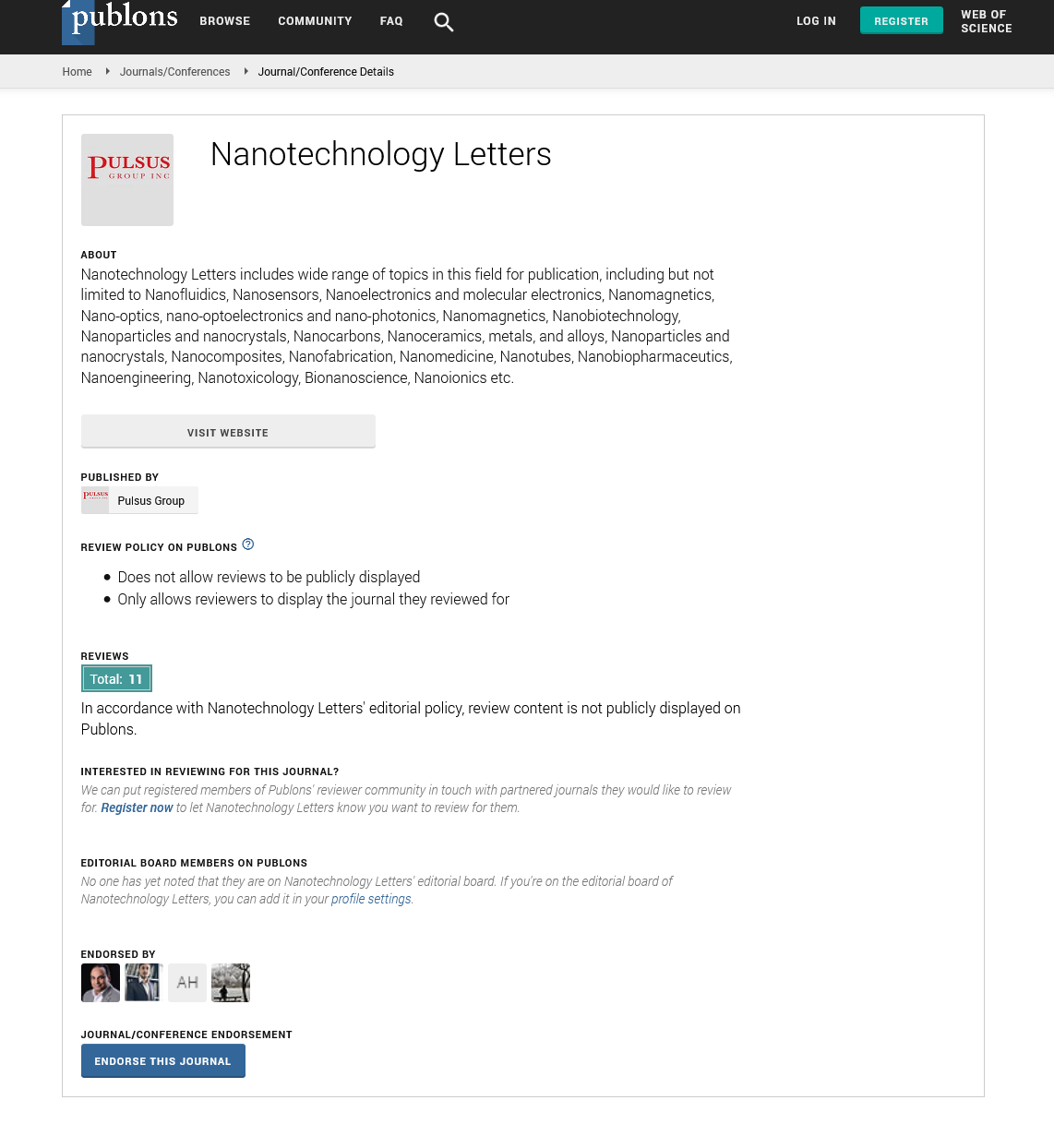Toxicology of carbon nanotubes in rodent models
Received: 13-Nov-2022, Manuscript No. PULNL-22-5865; Editor assigned: 15-Nov-2022, Pre QC No. PULNL-22-5865 (PQ); Accepted Date: Nov 25, 2022; Reviewed: 18-Nov-2022 QC No. PULNL-22-5865 (Q); Revised: 24-Nov-2022, Manuscript No. PULNL-22-5865 (R); Published: 29-Nov-2022, DOI: 10.37532. pulnl.22.7 (6)31-33
Citation: Pharasi D. Toxicology of carbon nanotubes in rodent models Nanotechnol. lett.; 7(6):31-33.
This open-access article is distributed under the terms of the Creative Commons Attribution Non-Commercial License (CC BY-NC) (http://creativecommons.org/licenses/by-nc/4.0/), which permits reuse, distribution and reproduction of the article, provided that the original work is properly cited and the reuse is restricted to noncommercial purposes. For commercial reuse, contact reprints@pulsus.com
Abstract
Due primarily to their small size over a huge surface area, carbon nanotubes are being used more frequently in nanomedicine and material chemistry research. They make excellent candidates for use in medicine as drug carriers, contrast agents, biological platforms, and other medical applications because of their characteristics. Evaluation of the hazardous consequences of Carbon Nanotubes (CNTs) is necessary since they may directly or indirectly impact various organs. Oxidative stress, inflammation, the capacity to harm DNA and cell membranes, necrosis, and apoptosis are some of the primary causes of toxicity. Research on CNTs focuses on various animal models, functionalization, delivery methods, concentrations, exposure durations, and a number of other features that have a big impact on toxicity.
Key Words
Nanotoxicity; Carbon nanotube; Animal model; Rodent
Introduction
Since Carbon Nanotubes (CNTs) can penetrate through holes or lipid bilayers, their high surface-to-weight ratio promotes surface reactivity. Their ability to assume many shapes, from fibrous to spherical, affects their characteristics and biological activities. CNTs have been used in medical and pharmacy studies because of their distinctive mechanical, optical, electrical, and chemical properties. These studies have included sensitive detection of important biological molecules, more precise and secure imaging of diseased issues, and cutting-edge forms of therapy.Due to the wide range of potential bonds that can form between carbon and other elements, carbon is one of the most adaptable elements on the periodic table. Another crucial factor is the strength of the bonds between carbon and various elements. The existence of allotropic variations, such as naturally occurring diamond, amorphous carbon, and graphite, as well as synthesised graphene, carbon nanotubes, fullerenes, or nanodiamonds, is made possible by the capacity of carbon orbitals to hybridise in sp, sp2, and sp3 configurations.
Graphene, which can be a single folded sheet termed single-walled (SWCNT) or a concentric multiple sheets known as multi-walled, is a modified nanomaterial that forms CNTs (MWCNT). Except for their ends, all carbon atoms in ideal CNTs are arranged in a hexagonal grid. Carbon nanotubes that are mass-produced include flaws that affect the sidewalls and the intended properties of these nanoparticles. Although polyhedral diameters can approach 100 nm, this is primarily dependent on the number of layers in the nanotube walls and the functional groups that are connected to them. SWCNT and MWCNT diameters range from 0.8 nm to 2 nm and 5 nm to 20 nm, respectively. The majority of SWCNTs are close to 1 nm in diameter and display significant electric characteristics that are absent from MWCNTs.
The elongated structure, high mechanical strength, high electrical conductivity, high thermal conductivity, metallic or semi-metallic behaviour, vast surface area, and extreme light weight of CNTs are further characteristics. CNTs are the preferred material in studies examining cancer therapy because of their nanometric size and great drug loading efficiency. In addition to being useful in combination therapies and photothermal and photodynamic therapy, CNTs are also employed to transfer medications or other tiny therapeutic molecules to target regions. CNTs can enter any type of cell due to their small size, including bacterial, yeast, and mammalian cells. Additionally, functionalized SWCNTs have been extensively researched for the delivery of anticancer medicines because biodistribution studies have showed that they aggregated in tumours. Numerous in vivo investigations have demonstrated the antitumor impact. Due to their lipophilicity and size, CNTs offer an intriguing vector for gene delivery since they can enter the cell directly through the plasma membrane without using endocytic pathways. They have also been applied in studies on the administration of cancer and other infectious disease vaccines. Combining an antigen with carbon nanotubes to maintain the proper shape and elicit a particular antibody response is the fundamental idea behind employing carbon nanotubes in vaccine delivery. CNTs are additionally employed in photothermal therapy as photothermal agents. Strongly absorbing light, they transform it into hyperthermia, which thermally vaporises neighbouring cells. However, using CNTs as a vehicle for the transport of drugs and genes or in cutting-edge nanotherapies shouldn't result in an immune response.
CNTs are a promising nanomaterial for biomedical applications because of their special mechanical, electrical, and optical capabilities as well as the ability to load them with different substances, including pharmaceuticals. In addition to being effective biocompatible biosensors and contrast agents for imaging, carbon nanotubes have the potential to increase the half-life of medications in the body and facilitate their direct distribution to cells. In the case of nerve cells in particular, they are helpful in cell proliferation and recolonization. We need a standardised process for the toxicological assessment of carbon nanotubes because there is a growing body of research focusing on unaltered and functionalized carbon nanotubes for biomedical applications.
Toxicological aspects of nanotubes
The use of carbon nanotubes in medicine has various benefits. However, the qualities that make them desirable for usage may also affect their toxicological profile in biological systems, therefore consideration must be given to their size, shape, and chemical makeup during manufacture. Concerns also include the way that cellular networks interact with one another, with the endocytic pathway, and with the absorption process, all of which can cause cytotoxicity and upset the homeostasis of cells.
The size of CNTs, which is closely related to their toxicological effects, is one of the most important elements affecting how they interact with biological systems. Smaller particles can absorb a lot more chemical molecules because they have a higher surface area per unit mass. As a result, the cellular environment becomes more reactive and has stronger toxicological effects. CNTs smaller than 10 nm have the potential to injure the lungs due to their enormous surface area and probable nuclear penetration, according to in vitro studies.
Numerous investigations on nanotoxicity include mice and rats. The biological condition of animal models can be quantitatively described using a wide range of indicators, such as clinical pathology and chemistry, organ and body weights, immunogenicity, and microscopic examination of tissues, which can then be used to predict human consequences.
Based on a comparison of the pharmacokinetics, target pharmacodynamics, and metabolism, rats and mice are suitable animals for toxicological investigations. They are excellent candidates for toxicological research due to their small size, brief lifespan, and generally laid-back disposition, in addition to their metabolic similarity. Major target organs and other systems vulnerable to the buildup of carbon nanotubes are included in the assessment of toxicity using rodent models, along with tissue structural alterations, apoptosis, and inflammation.
Pulmotoxicity of nanotubes
The two spongy, air-filled organs known as the lungs are in charge of carrying out gas exchange, which involves removing carbon dioxide and absorbing oxygen. The respiratory tract is constantly in contact with the environment through inhalation of dust and trash. As a result, the most important organ for carbon nanotubes breathed is the respiratory system. They are then disseminated throughout the body by translocation to blood. One of the most popular ways to consume CNTs is through inhalation. When pulmonary toxicity develops, particle size, functionalization, and dispersion all play a significant role.
Carbon nanotubes can enter the lower airway, travel to the alveoli, and then pass through the alveolar epithelium to enter the intrapleural area because of their small size. The forces that can affect particles are inertia, gravity, and diffusion, and in the case of CNTs, diffusion predominates. Particles less than 5 nm are deposited in the nasopharyngeal region, whereas bigger ones are deposited in the alveolar region, depending on the size of the carbon nanotubes, which influences their deposition.
Hepatotoxicity of nanotubes
The liver is a complex gland that serves a number of purposes. The liver is the principal organ in charge of inborn immunity because of Kupffer cells. The majority of the body's macrophages, known as kupffer cells, line the liver sinusoids, which are in direct contact with the blood. These macrophages serve as the reticuloendothelial system's component that traps circulating carbon nanotubes, making them an incredibly useful model for studying carbon nanotube toxicity. The metabolism and purification of the liver are carried out by the hepatic sinuses, Kupffer cells, and glomerular basement membrane.
Dermal toxicity of nanotubes
The largest organ in the body, the skin, has a significant impact on drug delivery. Since it is a surface organ, it is highly susceptible to exposure to carbon nanotubes since it could represent a significant route of exposure during production, use, or disposal. The membrane's lipids can be modified to improve their barrier properties by carbon nanotubes, which can also be attached to the material of interest and then penetrate jointly through pores or lipid bilayers.
To access the capillaries in the papillary layer of the dermis and enter the systemic circulation, they must be able to get past this dense barrier, crucial epidermis layers, and the link between the epidermis and the skin. They may have preventive activities when a disease or condition damages the stratum corneum. The size of the CNTs employed is between 100 nm and 200 nm in length and 2 nm in diameter, so they can pass through skin or may have an impact on chemicals' ability to pass through skin. The effects of carbon nanotubes when applied to the skin produce oxidative stress in mice, a decrease in glutathione content, and the oxidation of thiol groups, according to research by Murray et al. on the toxicity of carbon nanotubes. Changes were seen in mice after five days of exposure to SWCNTs at varying dosages. Rodents underwent modifications that led to an increase in dermal cells and a notable thickening of their skin.
Conclusion
Due to its special qualities, carbon nanotubes may be a very appealing material utilised in medicine and can be used as contrast agents, biological platforms, or medication carriers. Additionally, it is simple to give them powerful photothermal qualities and let them to stay away from the metallic core. The interactions of CNTs with biological systems and the generation of toxic responses lead to their toxicity. Furthermore, the degree of their danger relies on their physicochemical characteristics, the concentration used, and the exposure routes. According to studies, inflammation, oxidative stress, and disruption of cellular compartments are the key processes causing negative effects. Although carbon nanotubes appear to possess dangerous characteristics, this does not necessarily preclude their usage in nanomedicine. Direct comparisons between research are challenging because carbon nanotubes vary depending on the business and the time of manufacture.






